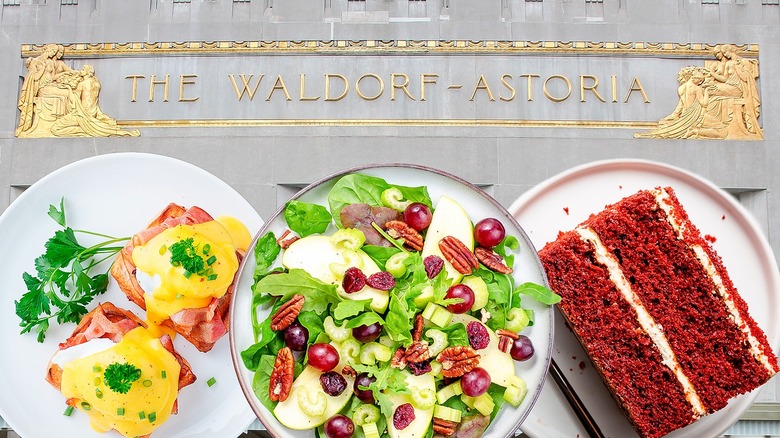A Legacy of Innovation and Elegance at the Waldorf-Astoria
The Waldorf-Astoria in New York City is more than just a hotel; it’s a symbol of luxury, history, and culinary innovation. Since its opening in 1893, the establishment has played a pivotal role in shaping American dining culture. While many of its original structures have been demolished and rebuilt, the spirit of the Waldorf remains intact, continuing to inspire chefs, bartenders, and food lovers alike.
Today, the hotel houses a new restaurant called Lex Yard, led by chef Michael Anthony. The menu features modern, refined dishes such as Long Island royal red shrimp, Baeri caviar, and chilled cucumber soup. But it’s not just about contemporary flavors—Lex Yard also serves one of the Waldorf’s most iconic creations: the Waldorf salad. This dish, which has become synonymous with the hotel, showcases the enduring influence of the Waldorf on American cuisine.
Iconic Dishes Born at the Waldorf-Astoria
The Waldorf salad is perhaps the most famous of the hotel’s culinary contributions. Created on the night of the hotel’s opening in 1893 by head chef Oscar Tschirky, the salad was initially made with apples, celery, mayonnaise, and lettuce. Tschirky reportedly disliked later additions like walnuts, but the simple combination became an instant hit among the socialites who dined there. According to historian David Freeland, the salad was designed to complement the elaborate meals of the time, offering a refreshing contrast to the rich courses served during dinner.
Another notable creation from the Waldorf is the Thousand Island dressing. Though its exact origin is debated, Freeland credits Oscar Tschirky with popularizing the condiment at the hotel. Some believe it was inspired by Sophia LaLonde, who may have created it during a trip to the 1,000 Islands. Regardless of its true beginnings, the dressing gained widespread recognition thanks to Tschirky’s efforts.
Drinks That Defined a Generation
The Waldorf-Astoria also played a key role in the development of classic cocktails. One such example is the Waldorf cocktail, which was originally much stronger than its modern counterpart. The original recipe, created by bartender Johnny Solon, included absinthe, whiskey, and Italian vermouth, making it a bold and complex drink. Despite its potency, the Waldorf cocktail didn’t gain immediate popularity, possibly due to the sheer number of other drinks available at the time.
The Rob Roy, another cocktail associated with the Waldorf, has a similarly contested history. According to Freeland, Albert Stevens Crockett, a contemporary writer, credited the Waldorf with creating the drink. The original recipe called for equal parts scotch and Italian vermouth, with a dash of orange bitters. While the origins of the Rob Roy remain unclear, the Waldorf’s bar was certainly a hub for cocktail innovation during the late 19th and early 20th centuries.
Surprising Stories and Unlikely Creations
Eggs Benedict, a beloved breakfast dish, also has ties to the Waldorf-Astoria. While both the Waldorf and Delmonico’s claim to have invented it, Freeland suggests that the dish may have been created independently at both establishments. The dish gained even more notoriety when Elizabeth Taylor ordered it during her honeymoon at the Waldorf in 1959, sparking a scandal that made headlines.
Red velvet cake, now a staple of American desserts, may have also found its roots at the Waldorf. Although the exact history of the cake is unclear, a popular legend claims that a guest once paid $300 for the recipe, only to share it out of spite. While the Waldorf denies this story, the cake’s rise in popularity coincided with the introduction of red food dye, making it a fitting addition to the hotel’s legacy.
Fried ice cream, another unexpected creation, was invented by Eugene Scanlan, the Waldorf’s first American head chef. Known for his innovative approach to dessert, Scanlan’s invention of fried ice cream would eventually become a staple at Renaissance fairs across the country. His work marked a shift in the hotel’s culinary identity, as he was the first American to hold the position of executive chef.
A Cocktail Named After the Zoo
Not all of the Waldorf’s contributions were serious. The Bronx cocktail, which combines gin, vermouth, and orange juice, was named after the Bronx Zoo rather than the borough itself. According to Freeland, bartender Johnny Solon came up with the name after visiting the zoo and drawing a connection between the unusual animals he saw and the wild visions patrons might experience after drinking too much. The name stuck, and the cocktail remains a fun and memorable part of the Waldorf’s legacy.
From salads to cocktails, the Waldorf-Astoria has left an indelible mark on American cuisine. Its history is a testament to the creativity and innovation of the chefs and bartenders who worked within its walls, and its influence continues to be felt today. Whether you’re savoring a Waldorf salad or sipping on a Bronx cocktail, you’re partaking in a tradition that spans over a century.



